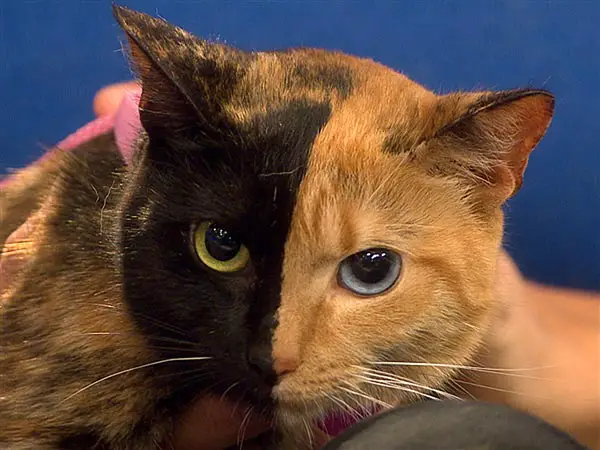Photograph courtesy TODAY Show/NBC
Katia Andreassi
National Geographic News
Published August 31, 2012
Venus The Two-Faced Chimera Cat

Famous feline may have different DNA on each side of her body.
Venus’s face is split evenly into two colors.
Venus the two-faced cat is currently the most famous feline on the planet.
The three-year-old tortoiseshell has her own Facebook page and a YouTube video that’s been viewed over a million times, and appeared on the Today Show last week. (Watch National Geographic cat videos.)
One look at this cat and you can understand why: One half is solid black with a green eye—the other half has typical orange tabby stripes and a blue eye.
How does a cat end up with a face that appears to be split in half?
Leslie Lyons, a professor at the University of California, Davis, who studies the genetics of domestic cats said she’s never seen a cat exactly like Venus.
“She is extremely, extremely rare,” Lyons said. “But you can explain it and you can understand it.”
Is Venus a Chimera Cat?
Many reports about Venus refer to the cat as a “chimera.” In mythology, a chimera is a mishmash monster made up of parts of different animals. A feline chimera is a cat whose cells contain two types of DNA, caused when two embryos fuse together.
Among cats, “chimeras are really not all that rare,” Lyons said. In fact, most male tortoiseshell cats are chimeras. The distinctively mottled orange and black coat is a sign that the cat has an extra X chromosome.
But female cats, said Lyons, already have two X chromosomes so they can sport that coat without the extra X. That means Venus is not necessarily a chimera.
To find out would require genetic testing, said Lyons. With samples of skin from each side of the cat, “we can do a DNA fingerprint—just like on CSI—and the DNA from one side of the body should be different than the other.”
Cat’s Blue Eye Another Mystery
If Venus isn’t actually a chimera, then what would explain her amazing face?
“Absolute luck,” Lyons said. One theory: perhaps the black coloration was randomly activated in all the cells on one side of her face, while the orange coloration was activated on the other, and the two patches met at the midline of her body as she developed.
Cat fanciers who are transfixed by Venus’s split face may be missing the real story: her single blue eye. Cat eyes are typically green or yellow, not blue.
A blue-eyed cat is typically a Siamese or else a cat with “a lot of white on them,” she explained.
Venus appears to have only a white patch on her chest, which to Lyons is not enough to explain the blue eye.
“She is a bit of a mystery.”
Courtesy National Geographic